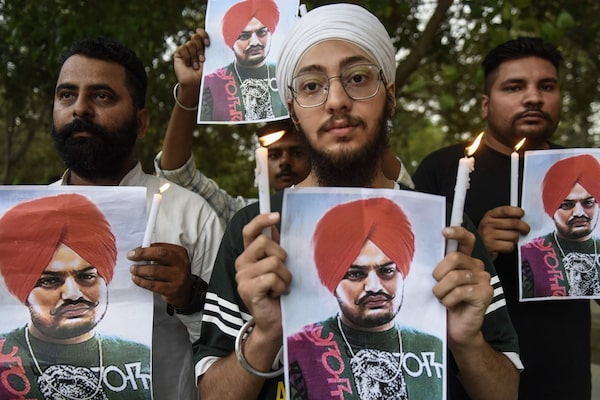
Youth pay tribute to late Punjabi singer Sidhu Moose Wala who was shot dead a day earlier in Mansa district in India's Punjab state, during a candlelight vigil in Amritsar on May 30.NARINDER NANU/AFP/Getty Images
The killing of Punjabi hip-hop star Shubhdeep Singh Sidhu has sent shockwaves across his fan base in Canada, particularly in the town of Brampton, Ont., where he spent much of the past six years.
Mr. Sidhu, better known by his stage name Sidhu Moose Wala, was shot dead in India on Sunday. The police in India said the 28-year-old singer was killed in a gang rivalry, which likely has ties to Canada. Mr. Sidhu had recently joined the political fray and unsuccessfully contested elections as a candidate for India’s principal opposition party, the Indian National Congress. The attack on him came a day after the Punjab state government withdrew his security detail.
While Mr. Sidhu was known and admired around the world, it was in Canada that he found recognition as a hip-hop icon. He thought of Brampton as his second home, and the city formed the landscape of much of his music. The video for his song B-Town, an homage to the Toronto suburb, starts with him getting into a Cadillac and driving through downtown Brampton. One lyric says, “Geetan’ch street’an nu rep karda,” which translates to “I represent the streets in my songs.”
The “Sidhu Moose Wala” name translates to “Sidhu, the man from Moosa.” Mr. Sidhu was born in Punjab’s Moosa village in 1993. In 2016, he was one of more than 270,000 people who came to Canada as an international student.
Since then, the country has seen a boom in such immigration. In 2019-20, before the pandemic slowed down immigration, the enrollment of international students – the majority coming from India – soared to 2.2 million. Mr. Sidhu’s meteoric rise coincided with this demographic change in Canada.
His story is part of local legend in Brampton. When Manpreet Singh, 29, came to Canada in 2017 as a student, Sidhu Moose Wala’s breakout hit G Wagon was on all his friends’ lips.
“Some of my friends knew Sidhu before he was famous. He lived in a basement apartment with some other boys his age, which is a rite of passage for all international students here. He was just like us,” Mr. Singh said. “For me, it’s his struggle that makes him such an icon.”
Within a short span of time spent in Canada, each of Mr. Sidhu’s videos racked up millions of views on YouTube. He rubbed shoulders with some of the world’s biggest musicians and counted global superstars, including Drake, among his 8.5 million Instagram followers.
But the appreciation for Brampton in his music never stopped, which some say contrasts with Canadian media’s negative portrayal of the city.
”Whenever you see Brampton in the news, it’s always for a homicide or theft or crime of some sort. It was nice for people to see their city in music videos rather than news clips,” said Arshdeep Singh Kang, another resident of the city who immigrated in 2017 as a student.
In 2018, after several media outlets reported the growing popularity of South Asian gangster rap in Canada, Sidhu Moose Wala wrote and performed Trend, a song in which he mocked the country’s mainstream media.
But Mr. Kang added that Mr. Sidhu often perpetuated those very same Brampton stereotypes and portrayed immigrant life unrealistically.
“Not everybody was a fan of the way he glorified guns,” Mr. Kang said. “A lot of people come to Canada after watching some of these music videos, thinking that life here is easy. But Brampton is a city of working-class people.”
Like Mr. Kang, critics have long called out Mr. Sidhu’s lyrics for glorifying gun culture and gang violence. In 2019, the City of Surrey in B.C. asked the organizers of a music festival to drop Sidhu Moose Wala’s performance based on an RCMP public-safety assessment. His Badfella music video shows him dominating white police officers in Brampton.
In 2020, he was charged with breaking the law in India after he fired an AK-47 rifle at a gun range during the country’s stringent COVID-19 lockdown. He responded by writing another song saying he was proud of the charges against him.
However, some believe it was precisely this bravado that struck a chord with some of Mr. Sidhu’s younger listeners.
“He was speaking to this young generation. He was an entertainer, he was writing what appealed to them,” said Nick Chowlia, a Vancouver-based radio host and musician.
Mr. Sidhu is also credited with pushing the envelope of Punjabi hip hop by combining conventional Punjabi pop music with trap.
”Before Sidhu, people used to look to India and the U.K. for the freshest Punjabi music. After his rise, Canada became the centre of the industry. There are many young kids in Canada for whom he is a trailblazer,” said Gursewak Dhillon, a rapper based in Abbotsford, B.C.
Indeed, for some Punjabi youth in Canada, Sidhu Moose Wala will continue to be an inspiration. Manpreet Singh, for example, has a day job as a truck driver, but he wants to make it big as a music-video director in Brampton.
“Because of Sidhu, the rest of us think it is possible for immigrants to make a living through our creative pursuits. After his death, I am more committed than ever to my art. All you have to do is not give up,” he said.
Our Morning Update and Evening Update newsletters are written by Globe editors, giving you a concise summary of the day’s most important headlines. Sign up today.